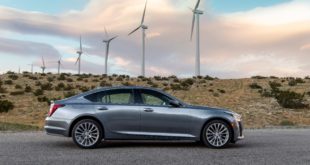
The latest Chevy Blazer sports an edge in ride and handling to go with the obvious ones on its skin. It’s no wallowy, pillowy crossover: with its raspy exhaust and firm ride, it reaches for an entertaining driving feel that’s been absent in Chevy crossovers.
We rate it a 7 for performance, with points for drivetrain and handling, but you’ll want to pay attention to the wheels, too.
Skip the base Blazer’s 2.5-liter inline-4. It churns out a miserly 193 hp and 188 lb-ft of torque, not quite enough to propel the Blazer’s heft—at least 4,007 pounds. It’s coupled to the front wheels through a well-programmed 9-speed automatic that holds in the lower gears for brisk launches, then picks from upper gears to cruise. The 4-cylinder moans at speed despite active noise cancellation, and isn’t particularly fuel-efficient.
In the middle this year, GM’s new turbo-4 gives the Blazer the powertrain it really needed at launch. The new engine spans the gulf between base and the big V-6 option with 230 hp and 258 lb-ft of torque, available all-wheel drive, and considerably more off-the-line perk than the base inline-4. The 9-speed thinks more and occasionally skips too many steps at low speeds as it tries to harmonize gas mileage and shift quality, but in most other ways the turbo-4’s quiet pull puts the mid-range Blazer where it needs to be, in acceleration and in price and in the availability of all-wheel drive.
GM’s burbly 3.6-liter V-6 tops the Blazer off with 308 hp and 270 lb-ft of torque. With a set of drive modes that range from all-wheel drive to sport mode, the V-6 and 9-speed combination has the brains and brawn to pull the Blazer with authority. It’s not quiet, but it’s on the right side of sporty and strong. Its all-wheel-drive system differs from the basic setup on 4-cylinder Blazers, which can disconnect the rear wheels and simply shift power front to back. The V-6’s twin-clutch rear differential can shift torque across the rear axle, for better traction and handling—and can tow up to 4,500 pounds.
The Blazer lineup has one thing in common across all its models: crisp handling and an assertive, firm ride. It begins with electric power steering and an independent suspension, and at a minimum, 18-inch 235/65 wheels and tires. Base versions handle mild road rash with firmness and a little fidgeting. The steering gains weight quickly from its light parking-lot feel, but the stiff tire sidewalls give the Blazer good highway tracking.
Blazer RS and Premier crossovers come with 20-inch wheels with an option for 21s. They’re actually blessed with a better ride with 265/45 tires, in spite of stiffer shocks and struts on the RS and quicker steering, too.
In sport drive mode, the Blazer RS’ sophisticated AWD system shifts power across its rear wheels for even better responsiveness. The RS has the road manners of a well-tuned sporty sedan: its transmission lingers in useful middle gears, the steering re-centers itself without much prodding. It’s stiff at low speeds, but the Blazer RS doesn’t need your advice to just chill.
Review continues below



